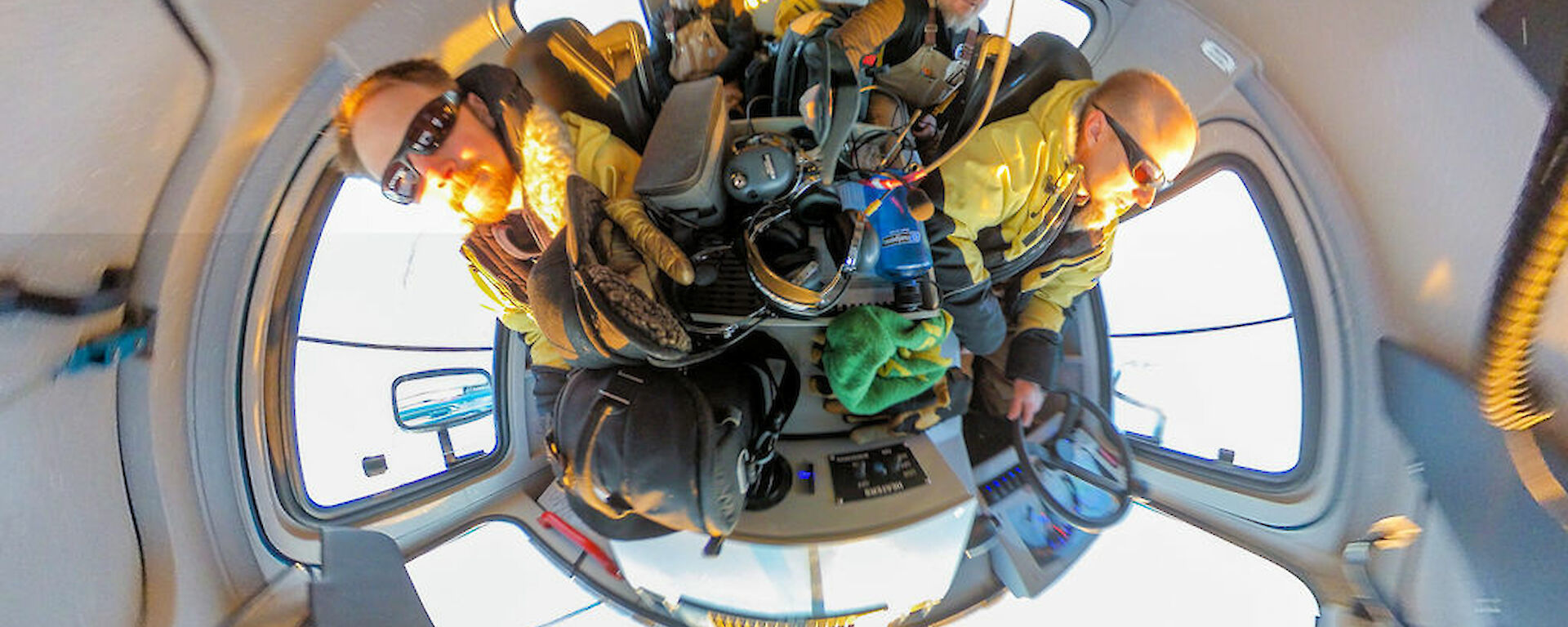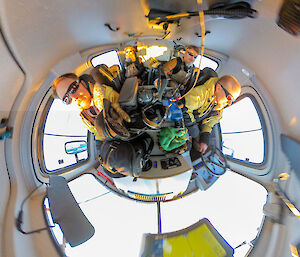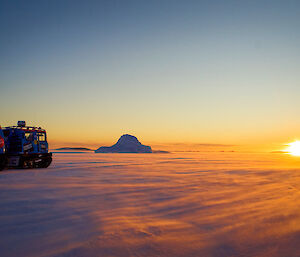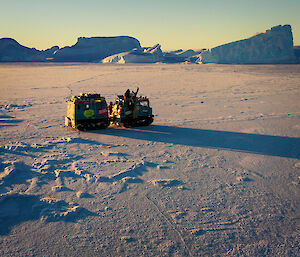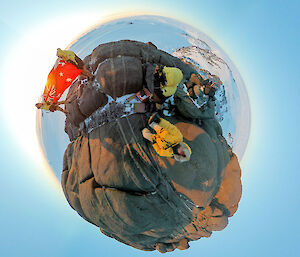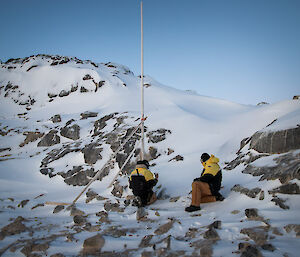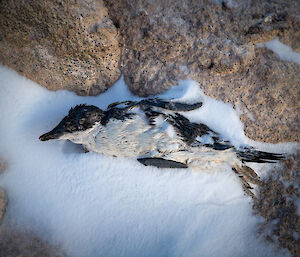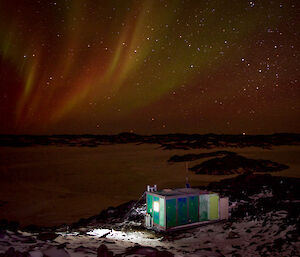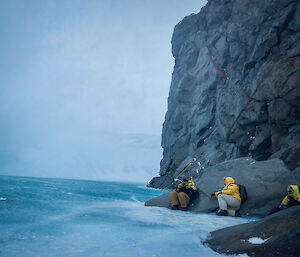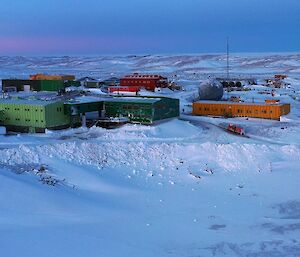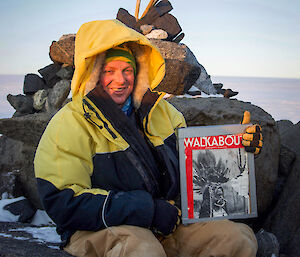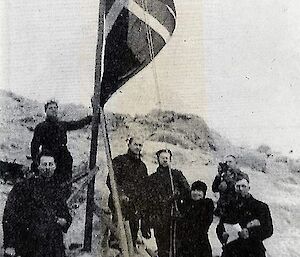Ryno, Dane, Kieran and Greg went on a rec trip on the weekend to see the sights at the top of the map. These included many icebergs, a couple of historic sites and a big frozen wave. Accommodation would be Bandits Hut on Saturday night.
Leaving straight after Chef Nick’s excellent smoko (food is the first layer against the cold) we packed the Blue Hägg with everything we needed, radioed we were on the sea ice and set off.
We took the scenic route out on the sea ice and through the icebergs for plenty of photo opportunities. However the further north-east we travelled toward our destination, the windier it got. Drifting snow gave the appearance that we were driving on clouds but stung our faces when we stepped out of the vehicle. The decision to take a Hägglunds and not quads was a good one.
Near the very top of our issued maps, just inside the Station Operational Area (outside of which we dare not go) is Walkabout Rocks and Sir Hubert Wilkins cairn. The rocks are a hill on edge of the Antarctic plateau. One side frozen sea ice, the other side buried by 30 metres of plateau ice.
Once we arrived we parked the Hägglunds into the wind so the doors would not be ripped off when opened, radioed in, rugged up and set off to find the cairn. Looking for a small pile of rocks on a large pile of rocks is not so easy. I had last visited 20 years ago and my memory of that trip was not helping today. But after a scramble to the summit the cairn was spotted a bit further on in a gully. Just as I remembered it.
Sheltering between the rocks we opened up the orange wooden box, then the metal box to find a proclamation claiming the area for the Commonwealth of Australia, a magazine titled Walkabout, a red ensign flag and various other knick-knacks.
Some history from Wikipedia: “In January 1939 a landing was made on the point, from HMAS Wyatt Earp, and a cairn erected by Hubert Wilkins with a canister containing a record of the event. It was subsequently visited by an ANARE (Australian National Antarctic Research Expeditions) party in May 1957 and the material left in the cairn in 1939 examined. The records were wrapped in a copy of the Australian geographical magazine Walkabout, hence the name given to the site.”
It is amazing to think that these items are 80 years old and still in such good condition. After carefully packing everything back in to its box we made our way back down the hill.
A slight detour on the way back brought us to Mikkelsen Island and her cairn, located in a small bay on a hill by a penguin colony. The cairn was mostly covered in snow but was easy to find as the flag pole has been stood back up after the site was rediscovered in the nineties.
Caroline Mikkelsen was the first woman to set foot on Antarctica. She arrived on the whaling ship MS Thorshavn in February 1935 and came ashore with her husband and seven crew. They raised the Norwegian flag, built a cairn at the site and had coffee and sandwiches (always remember your first layer).
Smoko next to a penguin colony must have been an experience. Hundreds of years of penguin droppings and corpses of the birds that didn’t make it creates a layer, several feet thick in places, of a crumbly, tan coloured mud. At this time of year it is thankfully frozen, but when thawed in summer it has an aroma that is quite overpowering.
On to our accommodation for the night. Bandits Hut is located on an island next to the iceberg clogged Tryne Sound. A well laid out hut made of freezer panels it is quite warm and cosy. Two bunk beds sleeps four, cold porch and outhouse on the side. The only downside is the 20 metre climb up from the coast.
Some cheese, olives, spring onions and other assorted nibbles while waiting for the 6:00pm radio sked. Then dinner and a few cold ones before bed. Ready for another day of seeing the sights.
Next morning I refuelled the generator to run the hut lights. Starting first pull it ran beautifully for 10 seconds then died. Several more tries got the same result. Dieso Dane to the rescue! After a quick look an oil overflow line was found clogged with ice. After melting out the ice the little Honda was purring away and the hut lit up ready for breakfast and packing up.
Not too far from Bandits Hut on the east side of Snezhnyy Bay there is a large, crescent shaped wind scour. Known as the Amphitheatre, it is formed by the wind flowing down the plateau and being forced around a hill. This has ablated away the ice, forming a frozen wave 20 metres high and in a half circle 400 metres long.
Putting ice spikes on our boots we battled up through the wind into the Amphitheatre. Inside was like being in a giant, vigorously shaken snow globe. We were almost knocked off our feet as the wind channelled between the hill and the ice wave. Blown snow stinging any exposed skin. Sheltering against the rocky hill we watched the gusts blow snow up the side of the scour before a lull let the snow cascade back down again like a waterfall. Circling around, the wind on our backs once we passed the half way point and were pushed out the other side. A short walk and we were back in our Hägglunds vehicle and out of the elements.
Time for some lunch (first layer again). Cheese and pickle sandwiches, bacon and roast potato, cheese toasties, chocolate bars. Everyone has their own favourite. The trick is to keep it warm so it’s not frozen hard by the time you get to it.
Once fed and watered it was an easy run back to station: south down Tryne Fjord, over Pioneer Crossing and into Long Fjord, turn right, out to the coast, turn left, down the coast past Plough and Anchorage Islands and finally another sharp left and straight in to station.
A final radio that we are off the sea ice and back on station. Then all that is left to do is turn our muster tags to say we are back on station, unpack the Hägg and put our survival packs away, dispose of the rubbish, poo bags and waste water drum, refuel the Hägglunds, park it up and close its blizz covers. And finally wash up ready for dinner (always take care of your first layer).
All up a good weekend rec trip with some real Antarctic weather conditions.
Greg Stone — Met Tech

